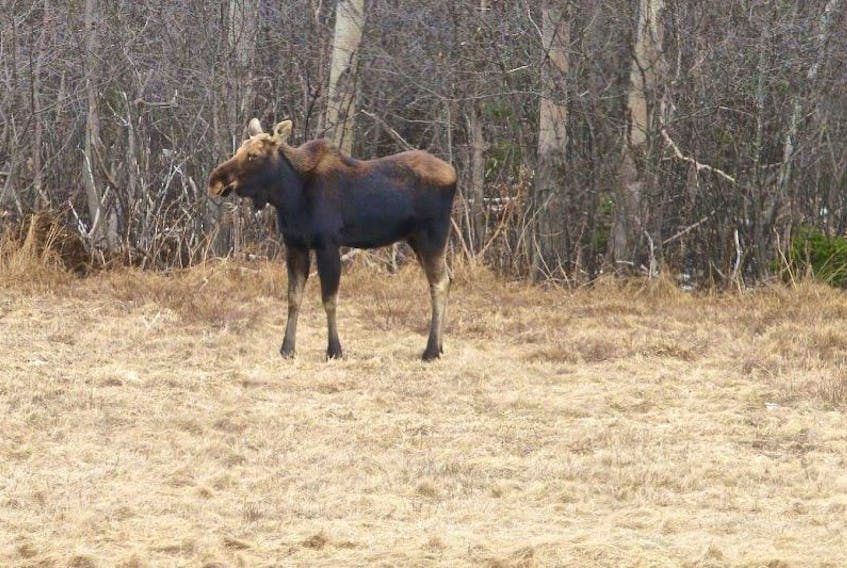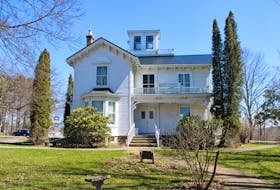For about a month, a young moose has been hanging out in the area.
For about a month, a young moose has been hanging out in the area.
“He hasn’t been here in the last day or two,” said Anderson, whose property has a willow tree that the moose likes to eat. “I came out one night… and he was munching away.”
Melissa Grant lives across the street and said Anderson’s field seem to be the moose’s favourite spot. She said he eats bark off the trees and even sleeps there.
She said the moose was a novelty at first – her three-year-old son likes to look at it from a distance – but now she’s more surprised when she doesn’t see it. “It was exciting the first time, but now we’ve seen it so much.”
Her sister Sarah Grant said: “It’s small, but I still wasn’t ready for how big it is.”
Melissa added that while it’s a small moose, it’s still a big animal – bigger than a horse.
Nancy Strickland, who lives farther down the road, said the moose has been in her yard about four times – appearing for a few days, going elsewhere for several days and then returning. She said a lot of cars have been driving up and down the lane looking for it.
“We see deer all the time, but never a moose. It’s just so rare.”
After examining a photo of the Abercrombie moose, Nova Scotia Department of Natural Resources biologist Shavonne Meyer said it’s a young male mainland moose, about two years old.
She said the low population density of moose on the mainland makes it less likely that one of the animals would stay around a residential area for this length of time, but it’s not unheard of.
“Moose and deer alike are not always deterred by presence of people, especially in residential areas that have the trees and habitat features that attract moose,” she said.
Meyer said the peninsular areas surrounding Pictou Harbour are known traditional moose grounds, and despite the small numbers of mainland moose, sightings are still reported every year.
“The moose will likely move on with seasonal changes. Food sources, like deliberate feeding or ornamental trees and shrubs, can attract moose.”
Grant said she’s seen people get a little too close to the wild animal, which makes her nervous.
Meyer said bull moose should be respected, and people should keep their distance, as they can be dangerous at times, especially if sick, injured, in poor body condition, or when they feel threatened. “Residents should refrain from approaching, baiting, feeding, calling, or provoking the animal in any way.”
She noted that the mainland moose is an endangered species under the Endangered Species Act, and any interference with it could be considered harassment, which is illegal. She recommends that people keep a good distance away, out of respect for the animal and as a public safety precaution.
DNR advises people to call the department’s toll free hotline (1-800-565-2224) for any immediate concerns about public safety, illegal activity, or the animal’s welfare.
“Otherwise, residents are encouraged to enjoy the rare sighting from a distance and continue to report sightings about the moose’s whereabouts and DNR will continue to monitor the situation,” she said.
Mainland moose in Nova Scotia
The mainland moose population is estimated at 1,000 animals or less.
The mainland moose is listed as an endangered species under the Nova Scotia Endangered Species Act.
Threats to the mainland moose population include disease (i.e. P. tenius, or brainworm), illegal kill (i.e. poaching), calf predation by black bears, habitat alteration and increased access, disturbance and possibly climate change and acid rain.
Moose cannot be legally hunted on the mainland. Because there is a conservation concern, Mi’kmaq harvesters are not permitted to hunt the animal on the mainland.
The last legal season for hunting moose on the mainland was in 1936 in the western end of the province and in 1981 in the eastern end.
Moose breed in September/October, this period is commonly referred to as “the rut.” Calves are born approximately eight months later, in late May/Early June.
Moose produce either a single or twin calf each year.
Moose are herbivores. They consume pondweed, and twigs and leaves from such trees as sugar maple, red maple, yellow birch and balsam fir.
In an unhunted population such as the mainland moose, the average lifespan is between 10 and 13 years of age.
Bull (male) moose have antlers, not horns. Bovines grow horns, which are permanent, unbranched structures that grow from the base. Antlers grow from the tip and are shed in January/February each year.
In a bull’s prime (usually between the ages of five and 12) new, often larger antlers grow back in late spring/early summer. They grow under velvet until September when the velvet is rubbed off on branches and the new antlers are revealed.
Source: Nova Scotia DNR









